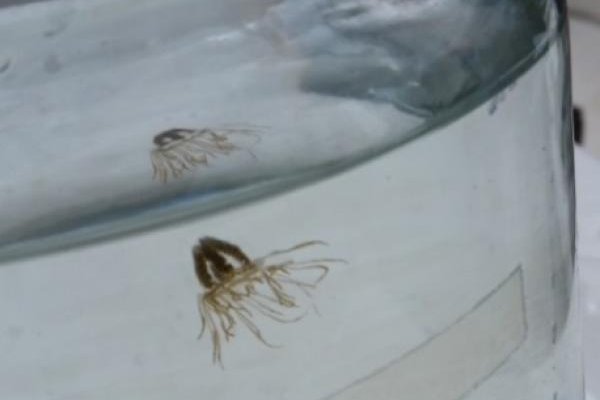
June 08, 2017
 NJ DEP//Provided photo
NJ DEP//Provided photo
Tiny and translucent clinging jellyfish with a potent poisonous venom have made an appearance on the New Jersey coast for the first time ever. Their sting can be excruciating. The DEP is studying them, hoping to map their occurrence and track their DNA to determine where they originated.
Remember those tiny, clinging jellyfish that invaded the Jersey Shore coastline last summer? The species whose venomous sting left a grown man hospitalized for two days after a swimming trip to the Shrewsbury River at Monmouth Beach?
They're back, according to the New Jersey Department of Environmental Protection, and wildlife officials are again conducting a study to better understand their distribution and breeding patterns.
No bigger than the size of a quarter, Gonionemus vertens was observed for the first time in New Jersey last June. A single observation in the Manasquan River led to further discoveries in the Shrewsbury River — about nine miles north of Asbury Park.
The sting of a clinging jellyfish, which has up to 90 tentacles, can feel similar to a jab with a hypodermic needle. What's worse is that they are extremely difficult to spot in the water. Last summer, the risk was considered so severe that water sports events on the Shrewsbury, Navesink and Manasquan rivers were canceled.
Fortunately for travelers to the Jersey Shore, the creatures haven't been found on coastal beaches and are not anticipated there. Their natural habitat is in the bay or surrounding estuaries where they can cling to vegetation.
This summer, the DEP and Montclair State University will sample at seven sites within the Shrewsbury River estuary, as well as Manasquan River and Northern Barnegat Bay. Seventeen small adult clinging jellyfish were already identified in the Shrewsbury River on June 2.
“This year’s individuals appear to be blooming at the same time as last year’s individuals,” said Dr. Paul Bologna, director of the marine biology and coastal sciences program at Montclair State University. “This suggests that annual blooms may become a common feature in New Jersey.”
The species, a native of the Pacific Ocean, developed Atlantic populations from Maine to the Carolinas but had skipped over New Jersey until last year. The reasons for its arrival remain the subject of ongoing investigation.
“One of the objectives of this continued study is to determine to what degree these clinging jellyfish are becoming established in our waters,” added Dr. Gary Buchanan, director of DEP’s Division of Science, Research and Environmental Health. “This species had not been reported previously in New Jersey before last year and appears to be mostly limited to the Shrewsbury River. The challenge now is to determine what extent the clinging jellyfish are maintaining a population in this specific estuary.”
A variety of habitat tests and genetic analysis will be completed on samples collected by DEP, which plans to release its findings to the public after the study has concluded.
For the upcoming summer, the public is advised to show common sense and caution during recreation in any of the areas where the jellyfish have been discovered.